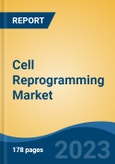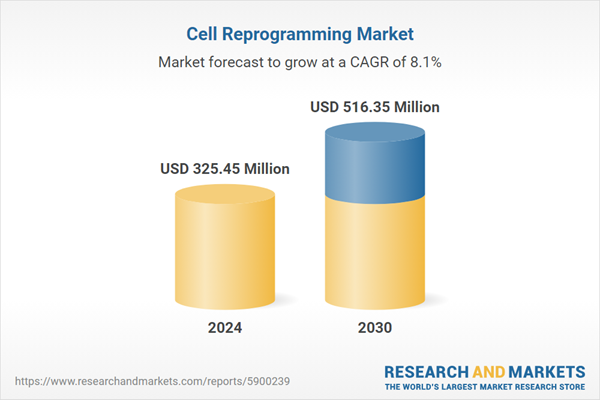Speak directly to the analyst to clarify any post sales queries you may have.
10% Free customizationThis report comes with 10% free customization, enabling you to add data that meets your specific business needs.
Cell reprogramming involves the conversion of mature, specialized cells into a more primitive state, often akin to embryonic stem cells. This process can be achieved through various techniques, with the most well-known being induced pluripotent stem cell (iPSC) reprogramming and direct lineage conversion. iPSC reprogramming allows scientists to take adult cells and rewind their developmental clock, making them pluripotent and capable of differentiating into various cell types. In contrast, direct lineage conversion skips the pluripotent stage, directly converting one cell type into another, such as turning skin cells into neurons.
The global cell reprogramming market is driven by a diverse range of applications. Cell reprogramming has the potential to revolutionize regenerative medicine by enabling the creation of patient-specific, functional cells for transplantation, thereby reducing the risk of rejection. Researchers can use pluripotent stem cell to create disease-specific cell lines, allowing them to study the molecular mechanisms of various diseases and screen potential drug candidates. Cell reprogramming plays a crucial role in drug screening and toxicity testing, reducing the need for animal testing and accelerating drug development. Pluripotent stem cell can be generated from individual patients, enabling the development of personalized therapies and treatment plans.
Key Market Drivers
Rising Prevalence of Chronic Diseases is Driving the Global Cell Reprogramming Market
The global healthcare landscape is witnessing a paradigm shift as chronic diseases continue to rise in prevalence. Diseases such as diabetes, cardiovascular disorders, neurodegenerative conditions, and cancer have become increasingly common, posing a significant challenge to healthcare systems worldwide. In response to this growing health crisis, the field of cell reprogramming is emerging as a promising frontier for addressing chronic diseases. The global cell reprogramming market is gaining momentum as researchers and biotechnology companies explore innovative ways to harness the regenerative potential of cells.For instance, the International Agency for Research on Cancer (IARC) projects that by 2040, the global cancer burden will rise to 27.5 million new cases and 16.3 million cancer-related deaths, largely due to population growth and aging. Additionally, an August 2022 article in the Radiation journal featured research by a Kindai University scientist in Japan exploring the optimal use of Radium-223 therapy for Metastatic Castration-Resistant Prostate Cancer. The study indicated that early administration of Ra-223 significantly improved overall survival (OS), highlighting potential advantages of using Ra-223 before novel hormonal or anticancer treatments.
Key Market Challenges
Technical Complexity
One of the primary challenges in the field of cell reprogramming is the technical complexity involved in generating high-quality iPSCs. Reprogramming adult cells into pluripotent stem cells is a delicate process that requires precise manipulation of cellular factors. Researchers must carefully select reprogramming methods, optimize culture conditions, and monitor cell differentiation to ensure the reliability and safety of iPSCs. This technical complexity not only demands considerable expertise but also makes the production of iPSCs time-consuming and costly.Key Market Trends
Technological Advancements
The field of regenerative medicine has been revolutionized in recent years, thanks to significant advancements in cell reprogramming technology. Cell reprogramming, a process that involves resetting the identity of mature cells to a pluripotent state, has opened new avenues for the treatment of various diseases and the development of personalized medicine.As technological innovations continue to accelerate, the global cell reprogramming market is experiencing unprecedented growth. The advent of CRISPR-Cas9 technology has significantly enhanced the precision and efficiency of cell reprogramming. Researchers can now edit specific genes within cells, eliminating potential genetic mutations that may hinder the successful reprogramming process. This innovation has accelerated the production of high-quality iPSCs for various applications.
Automation systems and high-throughput screening platforms have streamlined the cell reprogramming process. This allows for the rapid generation of iPSCs in larger quantities, making them more accessible for research and clinical use. Automated systems also reduce the risk of contamination and human error, ensuring consistent and reliable results. Technological advancements in 3D bioprinting and the development of organoids have expanded the possibilities of cell reprogramming. These techniques enable the creation of complex, tissue-like structures from iPSCs, paving the way for more advanced disease modeling and drug testing.
Artificial intelligence and machine learning algorithms have become integral in analyzing and interpreting large datasets generated from cell reprogramming experiments. These tools help identify novel factors and pathways involved in reprogramming, leading to more efficient and targeted approaches. Traditional methods of introducing reprogramming factors into cells often relied on viral vectors, which carried risks of genomic integration and mutagenesis. Non-viral delivery systems, such as synthetic RNA and protein-based approaches, have emerged as safer alternatives, improving the overall safety profile of cell reprogramming.
The global cell reprogramming market is witnessing remarkable growth, driven by these technological advancements and their applications. Pharmaceutical companies are increasingly investing in iPSC-based drug discovery and toxicity testing, while academic institutions are using iPSCs to study various diseases, including neurodegenerative disorders, heart disease, and cancer. Furthermore, the field of regenerative medicine is moving closer to the realization of personalized therapies. iPSCs derived from a patient's own cells can be reprogrammed and differentiated into specific cell types, offering the potential for individualized treatments and reduced risk of immune rejection.
Key Market Players
- Allele Biotechnology co. ltd.
- ALSTEM, INC
- Applied Biological Materials Inc.
- Axol Bioscience Ltd.
- Fujifilm Cellular Dynamics inc.
- Lonza Group AG
- Mogrify inc.
- REPROCELL Inc.
- Stemnovate Limited
- Thermo Fisher Scientific Inc
Report Scope:
In this report, the Global Cell Reprogramming Market has been segmented into the following categories, in addition to the industry trends which have also been detailed below:Cell Reprogramming Market, By Technology:
- Sendai Virus-based
- mRNA Reprogramming
- Others
Cell Reprogramming Market, By Application:
- Research
- Therapeutic
Cell Reprogramming Market, By End user:
- Research & Academic Institutes
- Biotechnology & Pharmaceutical Companies
- Hospitals & Clinics
- Others
Cell Reprogramming Market, By Region:
- North America
- United States
- Canada
- Mexico
- Europe
- France
- United Kingdom
- Italy
- Germany
- Spain
- Asia-Pacific
- China
- India
- Japan
- Australia
- South Korea
- South America
- Brazil
- Argentina
- Colombia
- Middle East & Africa
- South Africa
- Saudi Arabia
- UAE
Competitive Landscape
Company Profiles: Detailed analysis of the major companies present in the Global Cell Reprogramming Market.Available Customizations:
With the given market data, the publisher offers customizations according to a company's specific needs. The following customization options are available for the report.Company Information
- Detailed analysis and profiling of additional market players (up to five).
This product will be delivered within 1-3 business days.
Table of Contents
Companies Mentioned
- Allele Biotechnology co. ltd.
- ALSTEM, INC
- Applied Biological Materials Inc.
- Axol Bioscience Ltd.
- Fujifilm Cellular Dynamics inc.
- Lonza Group AG
- Mogrify inc.
- REPROCELL Inc.
- Stemnovate Limited
- Thermo Fisher Scientific Inc
Table Information
| Report Attribute | Details |
|---|---|
| No. of Pages | 182 |
| Published | March 2025 |
| Forecast Period | 2024 - 2030 |
| Estimated Market Value ( USD | $ 325.45 Million |
| Forecasted Market Value ( USD | $ 516.35 Million |
| Compound Annual Growth Rate | 8.1% |
| Regions Covered | Global |
| No. of Companies Mentioned | 10 |









